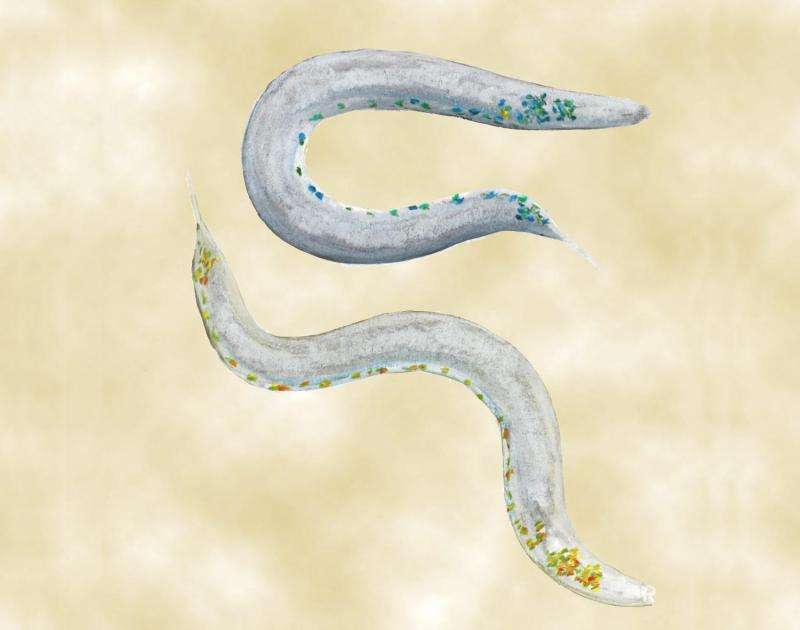How brains surrender to sleep

Scientists at the Research Institute of Molecular Pathology (IMP) in Vienna study fundamental aspects of sleep in roundworms. Using advanced technologies, they monitor the activity of all nerve cells in the brain while they are falling asleep and waking up. The journal Science publishes their ground-breaking results this week.
Sleep is a universal trait in animals: every nervous system seems to regularly undergo and require states of relaxation, during which brain activity is drastically altered. Sleep is vital, as we experience in our daily lives, but scientists are still debating why this is the case.
A team of neurobiologists led by Manuel Zimmer of the IMP Vienna used the roundworm C. elegans to study in detail how the brain switches between wakefulness and sleep. Their results suggest that in tired animals sleep is a ground state of the brain that spontaneously establishes itself as long as strong external stimuli from the environment are absent.
Manuel Zimmer compares such a state to a marble resting in a valley; to push it uphill requires some effort, but it will roll back by itself when left on its own. The equivalent is to arouse a sleeping worm, thereby pushing its brain into wakefulness, but if still tired and left unperturbed it will fall back to sleep. Scientists who deal with complex dynamical systems use the term 'attractor' for such processes. 'We propose this attractor mechanism as an efficient means how overarching states like sleep and wakefulness can propagate throughout an entire brain', says Zimmer.
Worms as models for sleep research
C. elegans was chosen as a model for sleep research because its nervous system consists of only 302 neurons. It is small enough for advanced microscopy approaches enabling access to the activity of all nerve cells in the brain at single-cell precision. This was key for obtaining new insights when monitoring the widespread reconfigurations that the brain undergoes between wakefulness and sleep.
Another challenge that the scientists faced was to control when worms would fall asleep and wake up. PhD-students Annika Nichols and Tomáš Eichler established an intriguing experimental system using variable oxygen concentrations as a switch. In their natural habitat, C. elegans live in soil where abundant microorganisms keep oxygen levels low. The researchers showed that under these preferred conditions the worms felt comfortable and could fall asleep, provided they were tired. Nichols and Eichler found that fresh air with atmospheric oxygen content alarms sleeping animals, causing them to rapidly wake up. 'This opened a door to effectively switch between the sleep and wake states during our experiments', says Nichols.
A neural meter for tiredness
Nichols went on and recorded the activity of all neurons in the brain while triggering switches between sleep and wakefulness. She found that during sleep, most nerve cells that are vigorously active during wakefulness, become silent. However, a few specific types of nerve cells stay alert. One of these types, termed RIS, was previously shown to promote sleep by excreting a sleep substance. Nichols showed that RIS activity is already elevated in awake animals that are prone to sleep, hinting that it is a measure of how tired the brain is.
Sleep as a default attractor state of the brain
When monitoring the activity of the brain as it fell asleep, Nichols made an interesting discovery: her computer analyses indicated that neuronal network activity spontaneously converged to a quiet and stable state. Originally, the researchers had assumed that RIS cells would force the nervous system into quiescence much like a conductor who silences the orchestra after the final chord. However, the new data suggest that RIS seems to act more like a mediator who negotiates an agreement between all players, followed by a collective action. The advantage of this scenario is that the dramatic changes between wakefulness and sleep can be triggered by rather subtly turning some of the regulatory knobs in the brain.
Despite the many differences between a worm brain and the human brain, these results provide a promising model for studying fundamental principles of brain organisation.
More information: A global brain state underlies C. elegans sleep behavior. Science, 23 Jun 2017. science.sciencemag.org/cgi/doi … 1126/science.aam6851



















